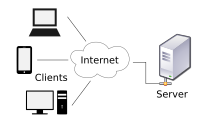Client (computing)

Client is a computer that gets information from another computer called server in the context of client–server model of computer networks.[1] The server is often (but not always) on another computer system, in which case the client accesses the service by way of a network.[2]
A client is a computer or a
A client is part of a
The term was first applied to
Types
| Relies on local storage |
Relies on local CPU
| |
|---|---|---|
| Fat client | Yes | Yes |
| Diskless node | No | Yes |
| Thin client | No | No |
In one classification, client computers and devices are either
Thick
A thick client, also known as a rich client or fat client, is a client that performs the bulk of any data processing operations itself, and does not necessarily rely on the
Thin

A thin client is a minimal sort of client. Thin clients use the resources of the host computer. A thin client generally only presents processed data provided by an
Diskless node
A diskless node is a mixture of the above two client models. Similar to a fat client, it processes locally, but relies on the server for storing persistent data. This approach offers features from both the fat client (multimedia support, high performance) and the thin client (high manageability, flexibility). A device running an online version of the video game Diablo III is an example of diskless node.
References
- ^ "1.1.2.2 Clients and Servers". Cisco Networking Academy. Retrieved 2024-04-07.
Servers are hosts that have software installed that enable them to provide information...Clients are computer hosts that have software installed that enable them to request and display the information obtained from the server.
- ISBN 978-0-470-22513-4.
- ^ a b c "client/server". PCMag Encyclopedia. Retrieved 8 November 2022.
- S2CID 723321.
